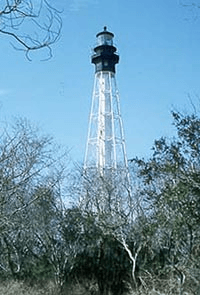Cape Charles Lighthouse facts for kids
 |
|
| Cape Charles Light in 1995 | |
|
|
|
| Location | Smith Island off Cape Charles at the mouth of the Chesapeake Bay |
|---|---|
| Coordinates | 37°07′23″N 75°54′23″W / 37.12292°N 75.90647°W |
| Year first constructed | 1828 |
| Year first lit | 1895 |
| Automated | 1963 |
| Deactivated | 2019 |
| Construction | cast iron skeleton tower |
| Tower shape | Octagonal pyramidal skeleton |
| Markings / pattern | lantern and watchroom, black tower, white |
| Height | 191 feet (58 m) |
| Focal height | 180 feet (55 m) |
| Original lens | First order Fresnel lens |
| Current lens | Vega VRB-25 solar-powered beacon |
| Range | 18 nautical miles (33 km; 21 mi) |
| Characteristic | Formerly Flashing white, 5 sec |
| Admiralty number | J1404 |
| ARLHS number | USA-109 |
| USCG number | Formerly 2-350 |
The Cape Charles Lighthouse is a very tall lighthouse located at the entrance of the Chesapeake Bay. It stands on Smith Island. This lighthouse was officially stopped from working in 2019. It is the tallest lighthouse in Virginia and the second tallest in the entire United States! This lighthouse tower is actually the third one built in this exact spot.
Contents
History of the Cape Charles Lighthouse
The First Lighthouse (1828)
The very first lighthouse at Cape Charles was built in 1828. It was a 55-foot (17 m) tall tower made of stone. However, it was quickly realized that this lighthouse was not tall enough. Ships at sea found it hard to see. Also, the land around it was eroding, meaning the ocean was slowly washing it away.
The Second Lighthouse (1864)
Because of the problems with the first lighthouse, a second one was built in 1864. This new lighthouse was much taller, at 150-foot (46 m). It was made of brick and looked a lot like the Cape May Lighthouse. It was painted white with a dark brown top.
To make it easier to see during the day, a red band was painted around the middle of the tower in 1892. But just like the first one, this lighthouse also started to be threatened by beach erosion. Even special walls built to protect it didn't work. By the 1890s, the lighthouse was very close to the ocean. It was decided that a third lighthouse was needed, built further inland.
The Third Lighthouse (1895)
The idea for the third Cape Charles Lighthouse was to make it out of iron plates. But in the end, a different plan was chosen. It was decided to build 191-foot (58 m) tall steel towers. These towers were built at both Cape Charles and Hog Island. This design was cheaper and looked different from the nearby Cape Henry Lighthouse. This made sure sailors wouldn't confuse the two.
How the Light Works
The new lighthouse's lens was put in place and tested in June 1895. However, it didn't start working full-time until August. This delay allowed sailors to learn about its new, special light pattern.
A unique idea was proposed for U.S. lighthouses: a "numerical flash" pattern. The lens at Cape Charles would spin completely around every thirty seconds. This created nine flashes:
- Four quick flashes
- A three-second dark period
- Five more flashes
- A sixteen-second dark period
This meant Cape Charles had a "4-5" pattern. Sailors could easily remember these numbers to identify the lighthouse. This system was like a fire alarm ringing out a building's exact number. Only two lighthouses ever used this expensive system: Cape Charles ("4-5") and Minots Ledge ("1-4-3").
The Tower's Design
The third and final Cape Charles tower is 191-foot (58 m) tall. This makes it the second tallest lighthouse in the United States. The tower has a central iron tube. Eight large legs surround this tube. Inside the tube, there is a spiral staircase with 216 steps. These steps lead up to the generator room. From there, seventeen more steps take you to the watch room. The tower is painted white, but the upper rooms are black.
Changes Over Time
The lens from the second Cape Charles Lighthouse was moved to the Hog Island Light in October 1895. On June 1, 1896, the speed of the new tower's lens was slowed down. The flashes were happening too fast to be seen clearly from far away.
The second Cape Charles Lighthouse was used as an observation tower during World War I. It finally fell into the ocean on July 2, 1927. Both the Cape Charles light and the Hog Island Light got electricity in 1933. This meant all coastal lighthouses in that area were now powered by electricity.
In 1963, the lighthouse became fully automated. This means it could run by itself without people. The old Fresnel lens was replaced with a more powerful light. The original lens from the Cape Charles lighthouse is now on display at the Mariners' Museum in Newport News, Virginia. The Cape Charles Lighthouse later used a special solar-powered light.
Recent History
On July 13, 2000, a brush fire burned down the main keeper's house. It also destroyed a small outdoor toilet and a storage shed. The homes for the assistant keepers had been torn down around 1960. The main keeper's house and other buildings were sold to a hunting club. Later, The Nature Conservancy took them over in 1995.
In 2013, the Cape Charles Light was reported as "extinguished," meaning it was no longer lit. It stayed that way until January 22, 2019. On that date, it was officially removed from service.
Even though you can see the Cape Charles lighthouse from the Chesapeake Bay Bridge–Tunnel, it's hard to visit. It's on a barrier island that is a nature preserve. You can only reach it by a small boat, and it's not open to the public.


